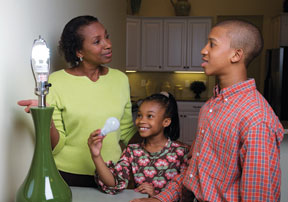5 Steps to Saving Time, Energy and Money When Buying Light Bulbs

Following these simple steps will help you save time, as well as energy and money.
Step 1: Know the fixture type (table lamp, recessed lights, pendant, chandelier, outdoor flood lamp, etc.).
Step 2: Look for the Energy Star label. Some incandescent bulb technologies -- including halogen -- are being promoted as energy efficient, but they're not much better than traditional incandescents. These bulbs turn a lot of electrical energy into heat to create light, which wastes energy. By switching to Energy Star-certified CFLs or LEDs -- which have met rigorous standards for energy efficiency and quality -- the Environmental Protection Agency estimates consumers will save more than $10 billion annually, or $143 per household, and avert the need for 30 new power plants.
Step 3: Read the Lighting Facts Label to select the bulb brightness. With CFLs and LEDs, you'll need to look at lumens (abbreviated: lm), not watts. Almost all packaging today will show the correlation between lumens for CFLs or LEDs and incandescent bulbs. Here's a quick reference: 100w equals 1,600lm, 75w equals 1,100lm, 60w equals 800lm, and 40w equals 450lm.
Step 4: Pick the light color you want. This is measured in Kelvins. The lower the number, the warmer the light (2,700-3,000K); the higher the number, the cooler the light (4,100K). Daylight is 5,500K-6,500K.
Step 5: Choose the Energy
Star bulb that has the additional features you need, such as the CFL shape (the familiar spiral, globe, covered A, tube and candle) and lighting levels (dimmable or three-way).
For more tips, go to NYSERDA's Bulbology resource: www.nyserda.ny.gov/bulbology.
The Lighting Research Center's Lighting Patterns for Homes eBook can help you simulate lighting technologies and patterns for your home: www.lrc.rpi.edu/patternbook/.

No comments: